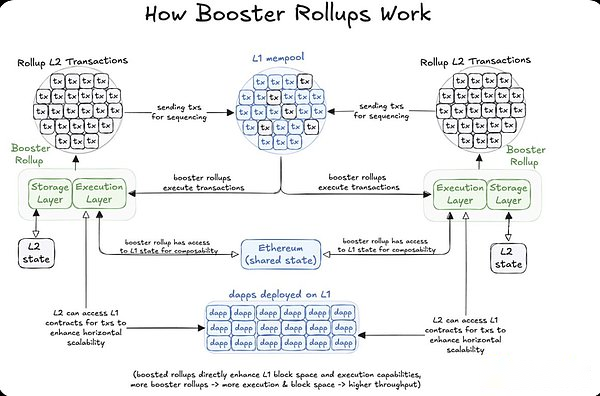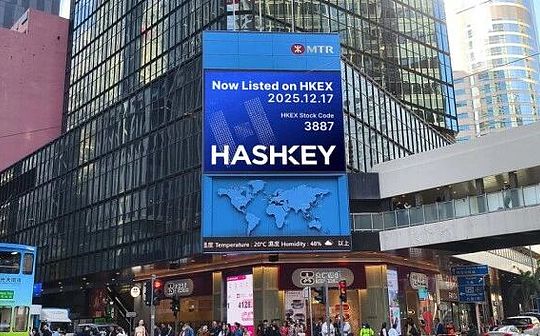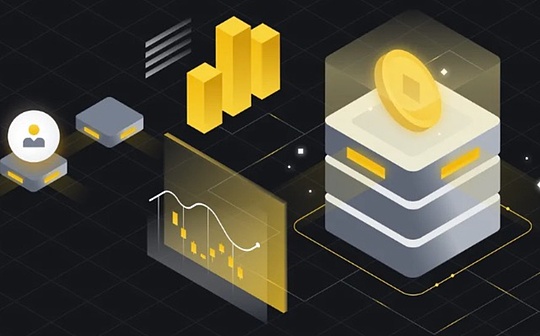
Author: 2077Research Source: X, @2077Research Translation: Shan Oppa, Bitchain Vision
In usRollups 2.0 SeriesIn our first article, we discuss Layer 1 (L1)-based rollup – a most decentralized and Ethereum-compatible way to manage rollups.By handing over the transaction sorting task to Ethereum L1, L1-based rollups can take advantage of L1’s decentralization, simplicity and activity, while also bringing other advantages.
In today’s article, we will explore the next evolution of rollup:Booster Rollups.Booster Rollups not only builds on the L1-based rollup, but also further expands the composability of Ethereum.But how do we really extend this composability?
Current L2 space problems
To ensure that the L2 network is functioning as expected, additional checks are often required.However, the main settlement and execution process still occurs directly on L1.This means that while L2 extends functionality (such as off-chain EVM execution), it also adds additional complexity.While this extra logic is not ideal, the ultimate goal is to standardize operations and rely entirely on standard EVMs.
standardizationIt is crucial to achieve smooth transaction exchanges between different L2s.To achieve this, a new type of transaction may be needed—transactions capable of operating across multiple chains.
In such a system, a transaction can generate smaller subtransactions.Each subtransaction contains the following details:
1. The ID of the source chain
2. The ID of the target chain
3. Enter data (such as caller, address, and call data)
4. The output generated by the target chain
The two major functions of this trading data:
1.As input on the source chain
It allows participants to view the output directly without directly involving the target chain.
2.Verify the consistency of input and output on the target chain
It is used to confirm whether the given input produces the expected output.
In this way, each chain can independently verify its transactions while following the sharing standards of transaction format and input.
This method keeps block verification simple, and block validity can be ensured using the familiar L1 verification contract.This sharing standards and improved cross-chain transaction method have laid a solid foundation for the future development of the L2 network and also madeBooster RollupsBecome the key to promoting the development of the Ethereum ecosystem.
How is Booster Rollups different?
Booster Rollups handle transactions similar to executing on L1, which can access the state of L1 but have independent storage, thus extending execution and storage to L2.Each L2 extends the block space of L1, spreading transaction processing and data storage to a wider range.
Imagine that it can automatically scale to all Layer 2 (L2) networks by deploying a decentralized application (dapp) once.If more block space is needed, just add more Booster Rollups without additional configuration.This means that developers don’t add workload, redeployment costs, or additional complexity.
Simply put, Booster Rollups is like adding more CPU or SSD to your laptop: they improve performance, make applications run more efficiently while easily scaling.
From a technical perspective, Booster Rollups can also be described as “distribute transaction execution and storage on multiple shards”.
How Booster Rollups Work
Booster function can be used whether it is optimistic Rollup (Optimistic Rollup) or zero-knowledge Rollup (ZK Rollup).However, not all Rollups require full boosting, and some Rollups can benefit from L2-specific optimizations.
If the goal is to achieve native Ethereum expansion, the best improvement scenario is to implement it on L1-based Rollup.Scaling Ethereum in a seamless way by having L1 validators propose blocks for the entire Boosted network.
Boosted Rollups also solves the fragmentation problem that is common in the current Rollup ecosystem.Through the L1-based sorting mechanism (Based Sequencing), they not only retain the advantages of L1 sorting, but also introduce atomic cross-rollup transactions within all L2 Booster networks.This design fulfills the scalability vision envisioned by Ethereum from the very beginning – both integrated and scalable, providing a unified solution to Ethereum’s growth challenges.

Because Booster Rollups naturally supports synchronous composability, this rollup model eliminates the hassle of dealing with fragmentation or switching between multiple L2s.All preferred decentralized applications (dapps) can be used on every L2, providing users with a seamless Ethereum experience.
With Booster Rollups, developers can scale their dapps without having to redeploy multiple times on multiple L2s.Just deploy once on L1 and dapps will automatically scale to all existing and future Boosted L2s, greatly simplifying the development and deployment process.
Because Booster Rollups naturally supports synchronous composability, this rollup model eliminates the hassle of dealing with fragmentation or switching between multiple L2s.All preferred decentralized applications (dapps) can be used on every L2, providing users with a seamless Ethereum experience.
With Booster Rollups, developers can scale their dapps without having to redeploy multiple times on multiple L2s.Just deploy once on L1 and dapps will automatically scale to all existing and future Boosted L2s, greatly simplifying the development and deployment process.
Advantages of Booster Rollups
1.Transparent expansion
Booster Rollups enhances scalability through transparent ways, just like adding more servers to a server farm.Applications can seamlessly utilize additional resources, and developers can scale solutions without deploying complex L2 infrastructure.
2.Solve fragmentation problems
Booster Rollups provides a unified user experience between L1 and L2.Because smart contracts share the same address across all networks, users can enjoy consistency and simplicity in L1 and L2 environments.
3.Solve the problem of inefficient deployment
Developers only need to deploy once on L1, and dapps can support multiple Rollups by default, and updates are managed centrally.Whether users use external accounts (EOA) or smart wallets, they can seamlessly trade across the network through a single address.
4.Solve the attraction of Rollup operators
Developers do not need to specifically choose to deploy the network, dapps will automatically support various Rollup networks.Booster Rollups can be used in conjunction with L1-based Rollups for significant capacity expansion.And, not all L2s need to be Booster Rollups, which makes hybrid networking possible.
5.Improvement of sovereignty and security
Booster Rollups eliminates the need for specific Wrapper Contracts, because smart contracts work the same way on L1 and L2, and control remains in the hands of developers.By applying security measures individually for each dapp, rather than relying on bridges or specific implementations, security is significantly improved while eliminating the risk of a single point of failure.
About the limitations of Booster Rollups
To ensure that L2 can be consistent with L1, the deployment of smart contracts should be limited to L1 only.This restriction ensures unified access between L2s.This is not a significant limitation, because smart contracts can still show different behaviors through data-driven methods, such as the contract addresses stored on the chain can vary between different chains.
Although L1 holds shared data, this does not directly improve scalability, which is a challenge inherent in any scalable system.Developers must optimize to minimize this impact.Similar to traditional software, not all decentralized applications (dapps) can fully utilize parallel processing.However, even if these dapps run on separate L2, they can still benefit from interoperability because they remain universally accessible to all users.
Booster Rollups are essentially an extension of L1, but they have unique mechanisms in transaction execution and storage.To correctly interpret Booster Rollup transactions, the L1 and L2 nodes must remain synchronized.A possible solution is to run L1 and L2 on the same node simultaneously, switching between shared L1 storage and L2 specific storage when executing transactions.
in conclusion
Booster Rollups provides a transformative solution that improves transaction throughput and storage efficiency through seamless integration with L1, thereby addressing the scalability challenges of Ethereum.They solve problems such as fragmentation and deployment inefficiency, allowing developers to easily scale dapps on multiple L2s while maintaining security and sovereignty.
By simplifying scalability and promoting interoperability, Booster Rollups paves the way for a more unified, user-friendly Ethereum ecosystem.








